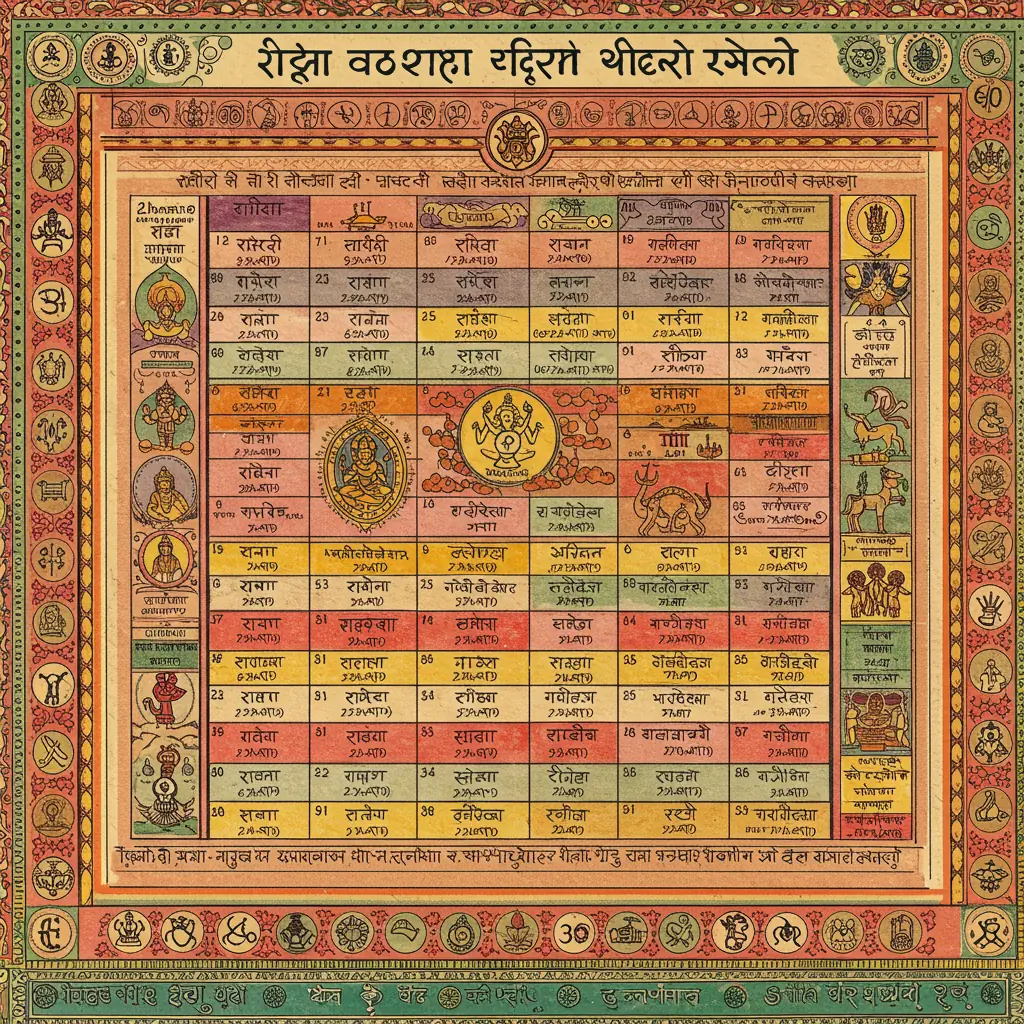Dainik (Today's) Panchanga at Jaipur





What is Panchang
Panchang as the name suggests, comprises of 5 aspects of the day - day of the week (vaar), tithi or the lunar day, nakshatra or the constellation, yoga, and karana. Panchang is one of the prominent Vedic astrology concepts, this calendar shows the position and movement of planets on a daily basis (via ephemeris). It helps in determining muhurata, tithi etc., which in turn helps in calculating important days, festivals, fastings etc.
Panchang is considered helpful in deciding muhurtas for any auspicious or new initiations. Panchang enlists shubh muhuratas as well as phases like the rahu kaal. Since minor changes in muhurata can impact the outcome of the work done during that duration, it is important to refer to an panchang developed by a reliable astrologer since it is based on minute calculations.
Understanding Panchang
A Panchang (पञ्चाङ्ग) is a traditional Hindu calendar and almanac. The word "Panchang" is derived from the Sanskrit words "Pancha" meaning five and "Anga" meaning limbs or parts. These five essential components form the basis of the Panchang and provide a comprehensive system for understanding time and its astrological influences. The five main angas of a Panchang are:
- Tithi (तिथि): This refers to the lunar day, which is the time it takes for the longitudinal angle between the Moon and the Sun to increase by 12 degrees. There are 30 Tithis in a lunar month, alternating between the waxing (Shukla Paksha) and waning (Krishna Paksha) phases of the Moon. Hindu calendar or panchang divides the month into two phases namely krishna paksha and shukla paksh. Krishna Paksh as the name suggests is when the nights are dark i.e. the moon is decreasing in size and contrary to it is the Shukla Paksha i.e. the moon is getting stronger. A 12 degree change in the position of the moon represents one tithi. There are 30 tithi in one month. It can also be called a lunar day. However, the tithi does not start with the sunrise or end with sunset. It can start at any point of time in the day. Most festivals fall on the purnima (full moon) or amavasya (no moon) tithis of the month. These tithis are further classified into 5 categories – Nanda, Bhadra, Jaya, Rikta and Poorna. Nanda is for joy and happiness, Bhadra is good to start new work, Jaya represents auspicious time for victory, Rikta is not a favourable one and Poona is considered good to do any kind of work.
- Vaara (वार): As you asked previously, this is the weekday or solar day. There are seven Vaaras in a week, each associated with a specific planet.
- Nakshatra (नक्षत्र): This denotes the lunar mansion or the constellation in which the Moon is located at a given time as per Hindu/Vedic Astrology and is governed by a specific Lord. The ecliptic is divided into 27 Nakshatras, each spanning 13 degrees and 20 minutes. Further, there are three categories of Nakshatra – Dev, Manushya and Rakshas. Here is a list of the 27 Nakshatras as they appear in the Panchang and Vedic astrology:
- 1. Ashwini (अश्विनी)
- 2. Bharani (भरणी)
- 3. Krittika (कृत्तिका)
- 4. Rohini (रोहिणी)
- 5. Mrigashira (मृगशिरा)
- 6. Ardra (आर्द्रा)
- 7. Punarvasu (पुनर्वसु)
- 8. Pushya (पुष्य)
- 9. Ashlesha (आश्लेषा)
- 10. Magha (मघा)
- 11. Purva Phalguni (पूर्व फाल्गुनी)
- 12. Uttara Phalguni (उत्तर फाल्गुनी)
- 13. Hasta (हस्त)
- 14. Chitra (चित्रा)
- 15. Swati (स्वाति)
- 16. Vishakha (विशाखा)
- 17. Anuradha (अनुराधा)
- 18. Jyeshtha (ज्येष्ठा)
- 19. Mula (मूल)
- 20. Purva Ashadha (पूर्वाषाढा)
- 21. Uttara Ashadha (उत्तराषाढा)
- 22. Shravana (श्रवण)
- 23. Dhanishtha (धनिष्ठा)
- 24. Shatabhisha (शतभिषा)
- 25. Purva Bhadrapada (पूर्व भाद्रपदा)
- 26. Uttara Bhadrapada (उत्तर भाद्रपदा)
- 27. Revati (रेवती)
- Yoga (योग): This refers to the angular relationship between the Sun and the Moon. There are 27 Yogas, each with its own significance and influence. It is calculated by adding the longitudes of the Sun and the Moon.
- Vishakumbha – Triumph
- Preeti – Joyful
- Aayushman – Enduring
- Saubhagya – Prosperity
- Shobhana – Allure
- Atiganda – Peril
- Sukarma – Abundance
- Dhriti – Enjoyment
- Shoola – Contentious
- Ganda – Concern
- Vriddhi – Insight
- Dhruva – Steadfast
- Vyaghaata – Intense
- Harshana – Delight
- Vajra – Authority
- Siddhi – Achievement
- Vyatipaata – Adversity
- Variyaana – Opulence
- Parigha – Obstacle
- Shiva – Benevolence
- Siddha – Accomplished
- Saaddhya – Mediation
- Shubha – Auspicious
- Shukla – Radiant
- Brahma – Trustworthy
- Indra – Leadership
- Vaidhriti – Divisive
- Karana (करण): A Karana is half of a Tithi. There are a total of 11 Karanas, with 7 movable (Bava, Balava, Kaulava, Taitila, Gara, Vanija and Vishti) and 4 fixed (These are – Kintughna, Chatushpada, Sakuni and Naga). Karanas are associated with actions and activities that can be undertaken during their duration. Out of all these Vishti Karana is considered the most inauspicious. The impact of different karan is different on individuals and only learned astrologers can help understand its impact on your life in detail.
